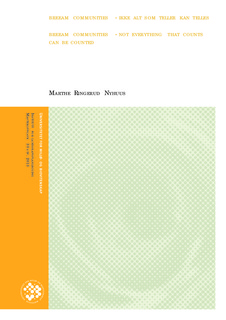BREEAM Communities - ikke alt som teller kan telles
Master thesis
Permanent lenke
http://hdl.handle.net/11250/188508Utgivelsesdato
2013-08-08Metadata
Vis full innførselSamlinger
- Master's theses (ILP) [763]
Sammendrag
Sammendrag
Bærekraft har vært en viktig målsetning i planlegging, politikk og samfunnsutvikling i mer enn 25 år. Det finnes mange sertifiseringsprodukter som skal sikre at hensynet til bærekraft er ivaretatt. Dette er nå også kommet for planlegging. BREEAM Communities er et sertifiseringssystem og et prosessverktøy for helhetlig områdeplanlegging, som skal sørge for at sosiale,- økonomiske og miljømessige forhold er ivaretatt og balanserte. Metodikken er et rammeverk med gitte tekniske standarder og prosessuelle krav, som kvalitetssikres av en uavhengig tredjepart. Produktet er en revisjon, altså et mål, på hvor bærekraftig prosjektplanen er jamfør standarder satt av BRE-Global. Det er kun planen som sertifiseres, ikke det realiserte prosjektområdet. Jeg har sett at det er lite kunnskap og manglende dokumentert effekt av å bruke verktøyet - allikevel er det på full fart inn planlegging.
Denne oppgaven er en studie om BREEAM Communities er egnet som verktøy for å etablere en kompakt, multifunksjonell, herunder bærekraftig by. Den tekniske manualen tilhørende verktøyet er analysert etter viktige parametere for å stimulere til bykvalitet. Resultatet av disse undersøkelsene viser at metoden ikke er egnet til å styre utviklingen til bedre bykvalitet, spesielt fordi den ikke oppmuntrer eller styrer fysisk,- demografisk,- eller funksjonell tetthet. Dessuten er det ikke alle forhold som kan sikres gjennom planlegging. Man kan oppmuntre og legge til rette for at ønsket utvikling skal finne sted, men man kan ikke alltid garantere utfallet. Derfor må en områdesertifisering med BREEAM Communities leses med en porsjon realisme i forhold til hva som oppnås og sikres gjennom planlegging.
Jeg har forsøkt å sette BREEAM Communities inn i en større kontekst for å løfte fokus og se studieobjektet som et produkt av vår tid. Nyliberalismen, især NPM, har hatt stor innvirkning på planlegging og er en forklaringsfaktor på hvorfor BREEAM har oppstått. Spesielt gjelder dette at prosessverktøyet er et produkt som bestemmer innhold og fremgangsmåte i planprosessen, samt at den utfører kvalitetssikring av arbeidet. Dette er en privatisering av en til nå offentlig oppgave, og som er en deregulering av makt bort fra staten.
Summary
Sustainability has been an important goal in planning politics and societal development for more than 25 years. There are many certified products on the market which promote sustainability. Sustainability is now implemented in urban planning. BREEAM Communities is a certification system and a tool for sustainable development which considers and connects social, economic, and environmental issues. The methodology includes a framework of required technical standards and procedures, assessed by a third party for quality. The result is an analysis which measures the level of sustainability of the planned project according to standards set by BRE-Global. It is only the planned project that is certified, not the built project itself. I have addressed that there is a shortage of knowledge and lack of documents that demonstrate the effects of using this tool, however this tool is gaining popularity in project planning.
This thesis is a study to find out if BREEAM Communities is an appropriate tool to establish a sustainable city which is compact and multifunctional. The technical manual associated with the tool is analyzed by important parameters to stimulate urban qualities. The result of these analyses shows that the method is not suited to steer the development necessary to improve city quality, especially because it doesn’t encourage or steer physical,- demographical,- or functional density. Furthermore there are issues that cannot be secured in planning alone. You can encourage and facilitate for things to happen, but you cannot always guarantee the outcome. This is why a certification with BREEAM Communities has to be understood and read in realistic terms of what is possible to achieve and secure through planning.
I have tried to place BREEAM Communities in a larger context and view it as a product of our time. Neo-liberalism, especially NPM, has had great influence on planning and explains why BREEAM has emerged. This especially applies to the fact that the tool controls the content and methodology in the planning process, and that it performs the quality assessment work.
